Table 9. Feature History Table
|
Feature Name
|
Release Information
|
Feature Description
|
|
Bandwidth Protection Functions to Enhance auto-tunnel backup Capabilities
|
Release 7.5.1
|
This feature introduces bandwidth protection functions for auto-tunnel backups, such as signaled bandwidth, bandwidth protection,
and soft-preemption. These functions provide better bandwidth usage and prevent traffic congestion and traffic loss.
In earlier releases, auto-tunnel backups provided only link protection and node protection. Backup tunnels were signaled with
zero bandwidth, causing traffic congestion when FRR went active.
This feature introduces the following commands and keywords:
|
The following example shows the auto-tunnel backup configuration for core or edge routers.
RP/0/RSP0/CPU0:router(config)#
mpls traffic-eng
auto-tunnel backup
tunnel-id min 60000 max 61000
interface pos 0/1/0/0
auto-tunnel backup
attribute-set ab
The following example shows the protection (NNHOP and SRLG) that was set on the auto-tunnel backup.
RP/0/RSP0/CPU0:router# show mpls traffic-eng tunnels 1
Signalling Summary:
LSP Tunnels Process: running
RSVP Process: running
Forwarding: enabled
Periodic reoptimization: every 3600 seconds, next in 2524 seconds
Periodic FRR Promotion: every 300 seconds, next in 49 seconds
Auto-bw enabled tunnels: 1
Name: tunnel-te1 Destination: 200.0.0.3 (auto backup)
Status:
Admin: up Oper: up Path: valid Signalling: connected
path option 10, type explicit (autob_nnhop_srlg_tunnel1) (Basis for Setup, path weight 11)
path option 20, type explicit (autob_nnhop_tunnel1)
G-PID: 0x0800 (derived from egress interface properties)
Bandwidth Requested: 0 kbps CT0
Creation Time: Fri Jul 10 01:53:25.581 PST (1h 25m 17s ago)
Config Parameters:
Bandwidth: 0 kbps (CT0) Priority: 7 7 Affinity: 0x0/0xffff
Metric Type: TE (default)
AutoRoute: disabled LockDown: disabled Policy class: not set
Forwarding-Adjacency: disabled
Loadshare: 0 equal loadshares
Auto-bw: disabled
Fast Reroute: Disabled, Protection Desired: None
Path Protection: Not Enabled
Auto Backup:
Protected LSPs: 4
Protected S2L Sharing Families: 0
Protected S2Ls: 0
Protected i/f: Gi0/1/0/0 Protected node: 20.0.0.2
Protection: NNHOP+SRLG
Unused removal timeout: not running
History:
Tunnel has been up for: 00:00:08
Current LSP:
Uptime: 00:00:08
Prior LSP:
ID: path option 1 [545]
Removal Trigger: configuration changed
Path info (OSPF 0 area 0):
Hop0: 10.0.0.2
Hop1: 100.0.0.2
Hop2: 100.0.0.3
Hop3: 200.0.0.3
The following example shows automatically created path options for this backup auto-tunnel.
RP/0/RSP0/CPU0:router# show mpls traffic-eng tunnels 1 detail
Signalling Summary:
LSP Tunnels Process: running
RSVP Process: running
Forwarding: enabled
Periodic reoptimization: every 3600 seconds, next in 2524 seconds
Periodic FRR Promotion: every 300 seconds, next in 49 seconds
Auto-bw enabled tunnels: 1
Name: tunnel-te1 Destination: 200.0.0.3 (auto backup)
Status:
Admin: up Oper: up Path: valid Signalling: connected
path option 10, type explicit (autob_nnhop_srlg_tunnel1) (Basis for Setup, path weight 11)
path option 20, type explicit (autob_nnhop_tunnel1)
G-PID: 0x0800 (derived from egress interface properties)
Bandwidth Requested: 0 kbps CT0
Creation Time: Fri Jul 10 01:53:25.581 PST (1h 25m 17s ago)
Config Parameters:
Bandwidth: 0 kbps (CT0) Priority: 7 7 Affinity: 0x0/0xffff
Metric Type: TE (default)
AutoRoute: disabled LockDown: disabled Policy class: not set
Forwarding-Adjacency: disabled
Loadshare: 0 equal loadshares
Auto-bw: disabled
Fast Reroute: Disabled, Protection Desired: None
Path Protection: Not Enabled
Auto Backup (NNHOP+SRLG):
Protected LSPs: 4
Protected S2L Sharing Families: 0
Protected S2Ls: 0
Protected i/f: Gi0/1/0/0 Protected node: 20.0.0.2
Protection: NNHOP+SRLG
Unused removal timeout: not running
Path Options Details:
10: Explicit Path Name: (autob_nnhop_srlg_te1)
1: exclude-srlg 50.0.0.1
2: exclude-address 50.0.0.2
3: exclude-node 20.0.0.2
20: Explicit Path Name: (autob_nnhop_te1)
1: exclude-address 50.0.0.1
2: exclude-address 50.0.0.2
3: exclude-node 20.0.0.2
History:
Tunnel has been up for: 00:00:08
Current LSP:
Uptime: 00:00:08
Prior LSP:
ID: path option 1 [545]
Removal Trigger: configuration changed
Path info (OSPF 0 area 0):
Hop0: 10.0.0.2
Hop1: 100.0.0.2
Hop2: 100.0.0.3
Hop3: 200.0.0.3
This example shows the automatically created backup tunnels.
RP/0/RSP0/CPU0:router# show mpls traffic-eng tunnels brief
TUNNEL NAME DESTINATION STATUS STATE
tunnel-te0 200.0.0.3 up up
tunnel-te1 200.0.0.3 up up
tunnel-te2 200.0.0.3 up up
tunnel-te50 200.0.0.3 up up
*tunnel-te60 200.0.0.3 up up
*tunnel-te70 200.0.0.3 up up
*tunnel-te80 200.0.0.3 up up
RP/0/RSP0/CPU0:router# show mpls traffic-eng tunnels tabular
Tunnel LSP Destination Source FRR LSP Path
Name ID Address Address State State Role Prot
------------------ ------ --------------- --------------- ------- ------- ------ -----
tunnel-te0 549 200.0.0.3 200.0.0.1 up Inact Head InAct
tunnel-te1 546 200.0.0.3 200.0.0.1 up Inact Head InAct
tunnel-te2 6 200.0.0.3 200.0.0.1 up Inact Head InAct
tunnel-te50 6 200.0.0.3 200.0.0.1 up Active Head InAct
tunnel-te60 4 200.0.0.3 200.0.0.1 up Active Head InAct
tunnel-te70 4 200.0.0.3 200.0.0.1 up Active Head InAct
tunnel-te80 3 200.0.0.3 200.0.0.1 up Active Head InAct
This example shows the auto-tunnel backup details.
RP/0/RSP0/CPU0:router# show mpls traffic-eng tunnels auto-tunnel backup detail
Name: tunnel-te400 Destination: 10.0.0.1 (auto-tunnel backup)
Status:
Admin: up Oper: up Path: valid Signalling: connected
path option 20, type explicit (autob_nnhop_te400) (Basis for Setup, path weight 2)
path option 10, type explicit (autob_nnhop_srlg_te400) [disabled]
G-PID: 0x0800 (derived from egress interface properties)
Bandwidth Requested: 0 kbps CT0
Creation Time: Thu Aug 16 18:30:41 2012 (00:01:28 ago)
Config Parameters:
Bandwidth: 0 kbps (CT0) Priority: 7 7 Affinity: 0x0/0xffff
Metric Type: TE (default)
Metric Type: TE (default)
Hop-limit: disabled
AutoRoute: disabled LockDown: disabled Policy class: not set
Forwarding-Adjacency: disabled
Loadshare: 0 equal loadshares
Auto-bw: disabled
Fast Reroute: Disabled, Protection Desired: None
Path Protection: Not Enabled
Soft Preemption: Disabled
Auto Backup:
Protected LSPs: 1
Protected S2L Sharing Families: 0
Protected S2L: 0
Protected i/f: Gi0/1/0/3 Protected node: 192.168.0.1
Attribute-set: ab1
Protection: NNHOP
Unused removal timeout: not running
Path Option Details:
10: Explicit Path Name: (autob_nnhop_srlg_te400)
1: exclude-srlg 34.9.0.4
2: exclude-address 34.9.0.3
3: exclude-node 192.168.0.1
20: Explicit Path Name: (autob_nnhop_te400)
1: exclude-address 34.9.0.4
2: exclude-address 34.9.0.3
3: exclude-node 192.168.0.1
SNMP Index: 221
History:
Tunnel has been up for: 00:00:34 (since Thu Aug 16 18:31:35 EST 2012)
Current LSP:
Uptime: 00:00:34 (since Thu Aug 16 18:31:35 EST 2012)
Current LSP Info:
Instance: 2, Signaling Area: OSPF 100 area 10.2.3.4
Uptime: 00:00:34 (since Thu Aug 16 18:31:35 EST 2012)
Outgoing Interface: GigabitEthernet0/1/0/2, Outgoing Label: 16000
Router-IDs: local 209.165.201.1
downstream 172.16.0.1
Soft Preemption: None
Path Info:
Outgoing:
Explicit Route:
Strict, 24.9.0.2
Strict, 12.9.1.1
Strict, 10.0.0.1
Record Route: Empty
Tspec: avg rate=0 kbits, burst=1000 bytes, peak rate=0 kbits
Session Attributes: Local Prot: Not Set, Node Prot: Not Set, BW Prot: Not Set
Soft Preemption Desired: Not Set
Resv Info:
Record Route:
IPv4 24.9.0.2, flags 0x0
IPv4 12.9.1.1, flags 0x0
Fspec: avg rate=0 kbits, burst=1000 bytes, peak rate=0 kbits
Displayed 1 (of 104) heads, 0 (of 0) midpoints, 0 (of 201) tails
Displayed 1 up, 0 down, 0 recovering, 0 recovered heads
This example shows the automatically created backup tunnels.
RP/0/RSP0/CPU0:router# show mpls traffic-eng tunnels auto-tunnel backup tabular
Tunnel LSP Destination Source Tun FRR LSP Path
Name ID Address Address State State Role Prot
----------------- ----- --------------- --------------- ------ ------ ---- -----
*tunnel-te400 2 10.0.0.1 209.165.201.1 up Inact Head Inact
*tunnel-te401 2 192.168.0.1 209.165.201.1 up Inact Head Inact
* = automatically created backup tunnel
RP/0/RSP0/CPU0:router# show mpls traffic-eng tunnels auto-tunnel backup brief
TUNNEL NAME DESTINATION STATUS STATE
*tunnel-te400 10.0.0.1 up up
*tunnel-te401 192.168.0.1 up up
* = automatically created backup tunnel
Displayed 2 (of 104) heads, 0 (of 0) midpoints, 0 (of 201) tails
Displayed 2 up, 0 down, 0 recovering, 0 recovered heads
This example shows the attribute-set for auto-backup tunnels.
RP/0/RSP0/CPU0:router# show mpls traffic-eng attribute-set auto-backup
Attribute Set Name: ab (Type: auto-backup)
Number of affinity constraints: 2
Include bit map : 0x4
Include name : blue
Exclude bit map : 0x2
Exclude name : red
Priority: 7 7 (Default)
Record-route: Enabled
Policy-class: 1
Logging: reoptimize, state
List of protected interfaces (count 1)
POS0_3_0_1
List of tunnel IDs (count 1)
3000
This example shows the attribute-set for auto-mesh tunnels.
RP/0/RSP0/CPU0:router# show mpls traffic-eng attribute-set auto-mesh
Attribute Set Name: am (Type: auto-mesh)
Bandwidth: 100 kbps (CT0)
Number of affinity constraints: 2
Include bit map : 0x8
Include name : yellow
Exclude bit map : 0x2
Exclude name : red
Priority: 2 2
Interface Bandwidth: 0 kbps (Default)
AutoRoute Announce: Disabled
Auto-bw: Disabled
Soft Preemption: Disabled
Fast Reroute: Enabled, Protection Desired: Node, Bandwidth
Record-route: Enabled
Policy-class: 0 (Not configured)
Logging: None
List of Mesh Groups (count 1)
1
This example shows the details about the tunnel that is using auto-backup type of attribute-set.
RP/0/RSP0/CPU0:router# show mpls traffic-eng tunnels attribute-set auto-backup ab
Name: tunnel-te3000 Destination: 10.0.0.1 (auto-tunnel backup)
Status:
Admin: up Oper: up Path: valid Signalling: connected
path option 20, type explicit (autob_nhop_te3000) (Basis for Setup, path weight 2)
path option 10, type explicit (autob_nhop_srlg_te3000) [disabled]
G-PID: 0x0800 (derived from egress interface properties)
Bandwidth Requested: 0 kbps CT0
Creation Time: Tue Aug 14 23:24:27 2012 (00:05:28 ago)
Config Parameters:
Bandwidth: 0 kbps (CT0) Priority: 7 7
Number of affinity constraints: 2
Include bit map : 0x4
Include name : blue
Exclude bit map : 0x2
Exclude name : red
Metric Type: TE (default)
Hop-limit: disabled
AutoRoute: disabled LockDown: disabled Policy class: 1
Forwarding-Adjacency: disabled
Loadshare: 0 equal loadshares
Auto-bw: disabled
Fast Reroute: Disabled, Protection Desired: None
Path Protection: Not Enabled
Soft Preemption: Disabled
Auto Backup:
Protected LSPs: 2
Protected S2L Sharing Families: 0
Protected S2L: 0
Protected i/f: PO0/3/0/1
Attribute-set: ab
Protection: NHOP
Unused removal timeout: not running
History:
Tunnel has been up for: 00:04:57 (since Tue Aug 14 23:24:58 EST 2012)
Current LSP:
Uptime: 00:04:57 (since Tue Aug 14 23:24:58 EST 2012)
Path info (OSPF 100 area 16909060):
Node hop count: 2
Hop0: 23.9.0.2
Hop1: 12.9.0.2
Hop2: 12.9.0.1
Hop3: 10.0.0.1
Displayed 1 (of 7) heads, 0 (of 3) midpoints, 0 (of 0) tails Displayed 1 up, 0 down, 0 recovering, 0 recovered heads
This example shows the protected interface for auto-backup auto-tunnels.
RP/0/RSP0/CPU0:router# show mpls traffic-eng tunnels backup protected-interface
Interface: Gi0/2/0/1 (auto-tunnel backup)
SRLG: N/A, NHOP-only: No
Attribute-set: Not configured
Auto-tunnel backup recreate time remaining: timer not running
No backup tunnel found
Interface: Gi0/2/0/3
tunnel-te340 PROTECTED : out i/f: PO0/3/0/2 Admin: up Oper: up
Interface: PO0/3/0/1 (auto-tunnel backup)
SRLG: N/A, NHOP-only: No
Attribute-set: ab
Auto-tunnel backup recreate time remaining: timer not running
*tunnel-te3000 NHOP : out i/f: Gi0/2/0/2 Admin: up Oper: up
* = automatically created backup tunnel
This example shows the details about all the tunnels that are using auto-mesh type of attribute-set.
RP/0/RSP0/CPU0:router# show mpls traffic-eng tunnels attribute-set auto-mesh all
Name: tunnel-te3501 Destination: 10.0.0.1 (auto-tunnel mesh)
Status:
Admin: up Oper: up Path: valid Signalling: connected
path option 10, type dynamic (Basis for Setup, path weight 2)
G-PID: 0x0800 (derived from egress interface properties)
Bandwidth Requested: 100 kbps CT0
Creation Time: Tue Aug 14 23:25:41 2012 (00:06:13 ago)
Config Parameters:
Bandwidth: 100 kbps (CT0) Priority: 2 2
Number of affinity constraints: 2
Include bit map : 0x8
Include name : yellow
Exclude bit map : 0x2
Exclude name : red
Metric Type: TE (default)
Hop-limit: disabled
AutoRoute: disabled LockDown: disabled Policy class: not set
Forwarding-Adjacency: disabled
Loadshare: 0 equal loadshares
Auto-bw: disabled
Fast Reroute: Enabled, Protection Desired: Node, Bandwidth
Path Protection: Not Enabled
Attribute-set: am (type auto-mesh)
Soft Preemption: Disabled
Auto-tunnel Mesh:
Group ID: 1
Destination list: blah
Unused removal timeout: not running
History:
Tunnel has been up for: 00:06:13 (since Tue Aug 14 23:25:41 EST 2012)
Current LSP:
Uptime: 00:06:13 (since Tue Aug 14 23:25:41 EST 2012)
Path info (OSPF 100 area 16909060):
Node hop count: 2
Hop0: 23.9.0.2
Hop1: 12.9.0.2
Hop2: 12.9.0.1
Hop3: 10.0.0.1
Name: tunnel-te3502 Destination: 172.16.0.1 (auto-tunnel mesh)
Status:
Admin: up Oper: up Path: valid Signalling: connected
path option 10, type dynamic (Basis for Setup, path weight 1)
G-PID: 0x0800 (derived from egress interface properties)
Bandwidth Requested: 100 kbps CT0
Creation Time: Tue Aug 14 23:25:41 2012 (00:06:13 ago)
Config Parameters:
Bandwidth: 100 kbps (CT0) Priority: 2 2
Number of affinity constraints: 2
Include bit map : 0x8
Include name : yellow
Exclude bit map : 0x2
Exclude name : red
Metric Type: TE (default)
Hop-limit: disabled
AutoRoute: disabled LockDown: disabled Policy class: not set
Forwarding-Adjacency: disabled
Loadshare: 0 equal loadshares
Auto-bw: disabled
Fast Reroute: Enabled, Protection Desired: Node, Bandwidth
Path Protection: Not Enabled
Attribute-set: am (type auto-mesh)
Soft Preemption: Disabled
Auto-tunnel Mesh:
Group ID: 1
Destination list: blah
Unused removal timeout: not running
History:
Tunnel has been up for: 00:06:13 (since Tue Aug 14 23:25:41 EST 2012)
Current LSP:
Uptime: 00:06:13 (since Tue Aug 14 23:25:41 EST 2012)
Path info (OSPF 100 area 16909060):
Node hop count: 1
Hop0: 23.9.0.2
Hop1: 172.16.0.1
Name: tunnel-te3503 Destination: 209.165.201.1 (auto-tunnel mesh)
Status:
Admin: up Oper: down Path: not valid Signalling: Down
path option 10, type dynamic
Last PCALC Error: Tue Aug 14 23:31:26 2012
Info: No path to destination, 209.165.201.1 (affinity)
G-PID: 0x0800 (derived from egress interface properties)
Bandwidth Requested: 100 kbps CT0
Creation Time: Tue Aug 14 23:25:41 2012 (00:06:13 ago)
Config Parameters:
Bandwidth: 100 kbps (CT0) Priority: 2 2
Number of affinity constraints: 2
Include bit map : 0x8
Include name : yellow
Exclude bit map : 0x2
Exclude name : red
Metric Type: TE (default)
Hop-limit: disabled
AutoRoute: disabled LockDown: disabled Policy class: not set
Forwarding-Adjacency: disabled
Loadshare: 0 equal loadshares
Auto-bw: disabled
Fast Reroute: Enabled, Protection Desired: Node, Bandwidth
Path Protection: Not Enabled
Attribute-set: am (type auto-mesh)
Soft Preemption: Disabled
Auto-tunnel Mesh:
Group ID: 1
Destination list: blah
Unused removal timeout: not running
Displayed 3 (of 7) heads, 0 (of 3) midpoints, 0 (of 0) tails Displayed 2 up, 1 down, 0 recovering, 0 recovered heads
Bandwidth Protection Functions to Enhance auto-tunnel backup Capabilities
Without bandwidth protection, auto-tunnel backups provide only link protection and node protection (per next-next-hop), and
backup tunnels are signalled with zero bandwidth. This causes traffic congestion when FRR goes active, since the backup tunnels
might be protecting huge amount of data, such as LSPs with large bandwidth or multiple LSPs.
To address the congestion issue, bandwidth protection capabilities are added for auto-tunnel backups. Bandwidth protection,
signalled bandwidth, and soft-preemption settings are provided. Details:
-
Bandwidth protection – A link or node protection backup might not provide bandwidth protection. But with this setting (bandwidth-protection maximum-aggregate), you can set the maximum bandwidth value that an auto-tunnel can protect.
-
Signalled bandwidth – Without bandwidth protection, auto-tunnel backups are signaled with zero bandwidth too, with no guarantee that at least
some bandwidth is backed up. So, the backup tunnels might be setup on links that are highly utilized, causing congestion drops
when the backup tunnels start to transmit traffic after FRR is triggered.
This setting (signalled-bandwidth) addresses the issue, since you can set the signalled bandwidth of the tunnel (and reserve minimal bandwidth for an auto-tunnel
backup). When you set the signal bandwidth value for auto-backup tunnels, congestion over backup links reduces.
-
Soft-preemption – Since bandwidth can be reserved for autobackup tunnels, a setting (soft-preemption) is provided for soft-preemption of the reserved bandwidth, if it is needed for a higher-priority tunnel.
Configurations
/*Enable Bandwidth Protection On a TE Auto-Tunnel Backup*/
Router# configure
Router(config)# mpls traffic-eng
Router(config-mpls-te)# interface GigabitEthernet 0/2/0/0 auto-tunnel backup
Router(config-te-if-auto-backup)# bandwidth-protection maximum-aggregate 100000
Router(config-te-if-auto-backup)# commit
/*Enable Signalled Bandwidth On a TE Auto-Tunnel Backup*/
Router# configure
Router(config)# mpls traffic-eng attribute-set auto-backup MyBackupConfig
Router(config-te-attribute-set)# signalled-bandwidth 700000
Router(config-te-attribute-set)# commit
After creating the auto backup attribute-set (MyBackupConfig in this case), associate with the auto-tunnel backup interface.
Router# configure
Router(config)# mpls traffic-eng
Router(config-mpls-te)# interface GigabitEthernet 0/2/0/0 auto-tunnel backup
Router(config-te-if-auto-backup)# attribute-set MyBackupConfig
Router(config-te-if-auto-backup)# auto-tunnel backup tunnel-id min 6000 max 6500
Router(config-mpls-te)# commit
/*Enable Soft-Preemption Bandwidth On a TE Auto-Tunnel Backup*/
Router# configure
Router(config)# mpls traffic-eng attribute-set auto-backup MyBackupConfig
Router(config-te-attribute-set)# soft-preemption
Router(config-te-attribute-set)# commit
Verification
/*Verify Auto-Tunnel Backup Configuration*/
In the output, bandwidth protection details are displayed, as denoted by BW.
Router# show mpls traffic-eng auto-tunnel backup
AutoTunnel Backup Configuration:
Interfaces count: 1
Unused removal timeout: 1h 0m 0s
Configured tunnel number range: 6000-6500
AutoTunnel Backup Summary:
AutoTunnel Backups:
0 created, 0 up, 0 down, 0 unused
0 NHOP, 0 NNHOP, 0 SRLG strict, 0 SRLG preferred, 0 SRLG weighted, 0 BW protected
Protected LSPs:
0 NHOP, 0 NHOP+SRLG, 0 NHOP+BW, 0 NHOP+BW+SRLG
0 NNHOP, 0 NNHOP+SRLG, 0 NNHOP+BW, 0 NNHOP+BW+SRLG
Protected S2L Sharing Families:
0 NHOP, 0 NHOP+SRLG, 0 NNHOP+BW, 0 NNHOP+BW+SRLG
0 NNHOP, 0 NNHOP+SRLG, 0 NNHOP+BW, 0 NNHOP+BW+SRLG
Protected S2Ls:
0 NHOP, 0 NHOP+SRLG, 0 NNHOP+BW, 0 NNHOP+BW+SRLG
0 NNHOP, 0 NNHOP+SRLG, 0 NNHOP+BW, 0 NNHOP+BW+SRLG
Cumulative Counters (last cleared 00:08:47 ago):
Total NHOP NNHOP
Created: 0 0 0
Connected: 0 0 0
Removed (down): 0 0 0
Removed (unused): 0 0 0
Removed (in use): 0 0 0
Range exceeded: 0 0 0

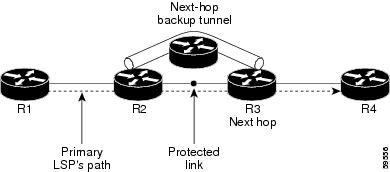
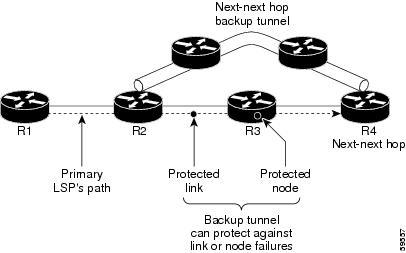





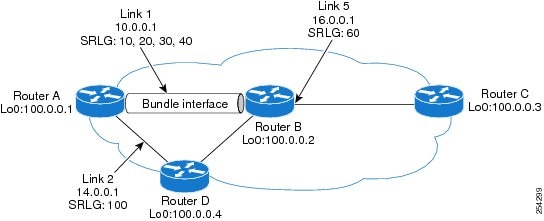
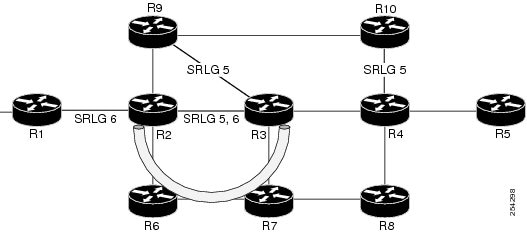
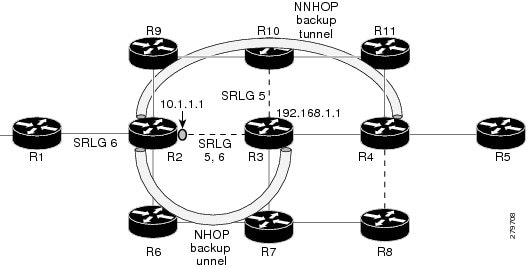














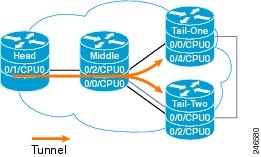
 Feedback
Feedback